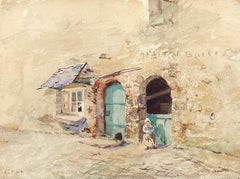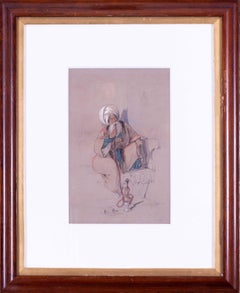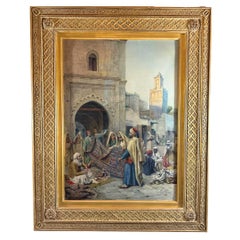Initialed lower left, 'C.H.' for Charles Constantine Hoffbauer (French, 1875-1957) and painted circa 1900.
Accompanied by the original artist-signed mat, original backing with inscription and newspaper clipping from Los Angeles Times' review of Hoffbauer's 1949 Legion of Honor Exhibition.
Mat dimensions: 12.75 x 13.5 Inches
An exceptionally fine and detailed, cabinet-sized gouache showing members of the Napoleonic guard relaxing in the courtyard of the Cathedral of Uspensky Sobor during France's brief occupation of Moscow during the fall of 1812.
Born in Paris in 1875, Charles Hoffbauer studied at the Ecole des Beaux-Arts under Fernand Cormon and Gustave Moreau and, during his studies, became acquainted with Matisse, Rouault, and Marquet. He was the recipient of numerous prizes, medals and juried awards including an Honorable Mention in the Salon of 1896, and prizes at the Salons of 1898 and 1899. He was awarded a bronze medal at the Paris Universal Exposition of 1900 and, in the same year, a French government scholarship, the Prix National du Salon, that allowed him to travel and study in Italy, Greece and Egypt. In 1902, he won the Prix Rosa Bonheur. At the Salon of 1904, the French government purchased 'Champs de Bataille' for the Musée du Luxembourg and Hoffbauer was elected a member of the Legion of Honor.
Hoffbauer served in the French Army as an official war artist during the first world war, winning the Croix de Guerre and acting as liaison officer to the American camouflage section. On the recommendation of the mural painter, James Wall Finn, Hoffbauer received the 1935 commission to paint the murals for Battle Abbey, the Confederate memorial in Richmond, Virginia. He revisited America to accept a commission for the mural in the Missouri State Capitol, and was appointed to membership of the jury of the 1937 International Exposition. Two years later, he became an American citizen and settled in Rockport, Massachusetts. Charles Hoffbauer's work may be found in the permanent collections of numerous national museums including the Museum of Modern Art in Paris.
Reference:
Who Was Who in American Art 1564-1975: 400 Years of Artists in America, Peter Hastings Falk, Sound View Press 1999, Vol. 2, p. 1585; Thieme-Becker Allgemeines Lexikon der Bildenden Künstler von der Antike bis zu Gengenwart, Ulrich Thieme and Felix Becker, Deutscher Taschenbuch Verlag 1992, Vol. 17/18, p. 246; E. Benezit, Dictionnaire des Peintres, Sculpteurs, Dessinateurs, et Graveurs, Jacques Busse, 1999 Nouvelle Édition, Gründ 1911, Vol. 7, p. 105; Biographical Encyclopedia of American Painters, Sculptors & Engravers of the U.S.: Colonial to 2002, Bob Creps, Dealer’s Choice Books, Inc. 2002, Vol. 1, p. 643; Steen, James T. "The Story of a Painting," Carnegie Magazine 31/32 (February 1957): 57-59; Charles Hoffbauer (1875-1957). Drawings, Temperas & Oil Paintings. Exh. cat. Somerville, MA: Gropper Art Gallery, 1977; Glueck, Grace. New York: The Painted City. Salt Lake City: Peregrine
Smith Books...



